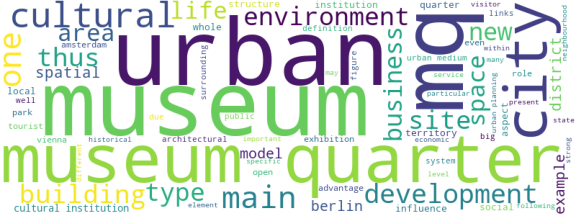| Id | 520 | |
| Author | Kochergina E. | |
| Title | Urban Planning Aspects of Museum Quarters as an Architectural Medium for Creative Cities | |
| Reference | Kochergina E.; Urban Planning Aspects of Museum Quarters as an Architectural Medium for Creative Cities ;IOP Conference Series: Materials Science and Engineering vol:245.0 issue: 5 page: |
|
| Link to article | https://www.scopus.com/inward/record.uri?eid=2-s2.0-85033717644&doi=10.1088%2f1757-899X%2f245%2f5%2f052031&partnerID=40&md5=c3f3e475433e9b791e289992a4792c10 |
|
| Abstract | Since the second half of the 20th century, urban environment has experienced significant transformation. Splash of interactivity, bottom-up initiations with development of creative sector of city economy and participatory planning, irretrievably changed the attitude to the urban medium. One of the most intensively growing field-creative industry-provided cities with numerous cultural clusters, which boosted urban economic development and social cohesion. Supported in many cases by gentrification and revitalization, these processes brought renovation of brownfield and more comprehensive approaches to urban design. Understanding of the economic benefits made city managers start an active promotion of creative clusters and their intensive integration into urban life, involving the main museums and cultural institutions. Thus, a new type of cultural clusters-Museum Quarter-appeared. Holding the position of cultural flagman in the historical heart of the city, Museum Quarters (MQs) pretend to take on an important role both in urban planning structure and in social life. Furthermore, such role usually has strong influence on the surrounding districts, in a positive or negative way. Although basic principles are still applied for all types of cultural districts, the phenomena of Museum Quarters due to the complexity of planning, operating and maintenance issues, stepped far above basic cultural clusters, requiring substantially new attitude to the planning of such urban entities. Five clusters were chosen for this study: MQs in Vienna, Berlin, Amsterdam, Copenhagen and the currently developing project in Budapest. The main purpose of this paper is to elaborate the principles for the practical implementation of Museum Quarters by the definition and classification of their specific urban planning aspects. The complexity of target object-Museum Quarter-and its multi-level relationships with the whole city, require from the research interdisciplinary approach and methodology of systemic-structural analysis. The typology of different MQs-identifying specific and common features-is based on studies of urban grids and architectural characters. The critical observation and comparison of the sociopolitical background and the traditional and modern understanding of museum environment helped to define some crucial misconceptions in interpretation, such as the widespread attitude to the Museum Quarter as a museum building, not as a part of urban medium, causing documented obstacles to development. Consideration of drawbacks and advantages, as the results of this study, showed potential of Museum Quarters as new models of urban environment for smart-governed, economically and socially sustainable contemporary city life. © Published under licence by IOP Publishing Ltd. |
|
| Keywords |
Wordcloud:



